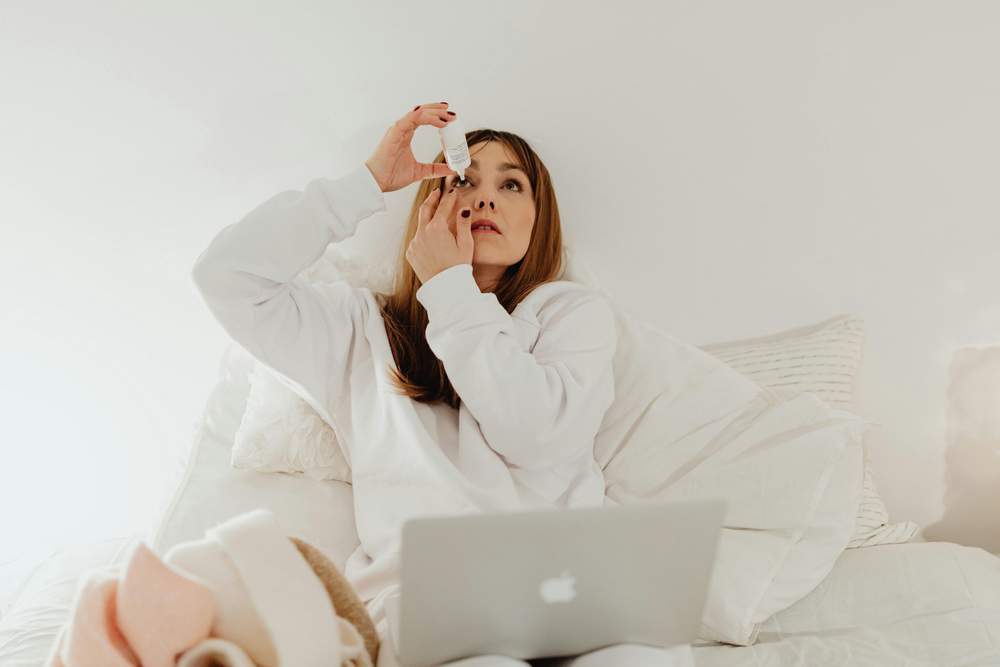Dry eye disease (DED) is a condition in which your eyes aren’t producing an adequate amount of tears necessary for lubrication. As a result, this may lead to inflammation and damage to the eye’s surface.
Unfortunately, more Americans may be suffering from this condition than we think. According to a recent dry eye survey from eye health products company Bausch + Lomb, there has been an increase in the prevalence of dry eye, particularly among younger demographics due to modern lifestyles and heavy digital device use. Of 2,003 survey participants, 461 were considered “sufferers” of dry eye disease symptoms.
Worse, most of the participants lacked awareness of the symptoms associated with eye dryness, which includes redness, fluctuating vision, scratchiness, and a gritty, tired, or heavy feeling in the eye. Additionally, 70% stated they knew little about preventing or treating dry eye. 44% of participants were also unaware that untreated DED can lead to vision loss, among other complications.
The treatment of dry eye disease and its associated symptoms start with routine visits to eye care providers. Unfortunately, about two in five participants stated they do not visit their eye care provider at least once a year. As a result, early symptoms of the disease are often misunderstood, underestimated, or ignored.
Dry eyes and other diseases
While findings from recent years have associated dry eyes with the increased use of digital devices, it’s important to note that dry eyes can also point to other diseases and health conditions. Illnesses like lupus, Graves’ disease, and diabetes are considered causes of dry eye, and women who experience hormonal changes after menopause and during pregnancy also tend to experience heightened dry eye symptoms.
Similarly, staying or spending long periods in dry, indoor environments can lead to dry eyes or decreased production of tears. Regular contact lens wearers are also no strangers to dry eyes, as most modern contact lenses can partially block oxygen from properly entering the eye.
Meanwhile, other health conditions can also cause dry eye and associated symptoms due to the medications required to treat them. This includes tranquilizer, antihistamines, certain heart medications, diuretics, birth control pills, and ulcer medications.
Prevention and treatment of dry eye
As mentioned, despite the rising prevalence of dry eye disease and its various symptoms, many people lack awareness about available treatment and prevention methods. One of the best ways to prevent dry eye symptoms, of course, is to visit an eye doctor regularly.
Routine eye checkups can help eye care professionals detect eye conditions as early as possible, including vision changes out of the ordinary or even hidden medical issues. Fortunately, the Internet has made it much easier for people to access eye exams carried out by qualified eye care professionals. A simple search for “eye exam near me” will lead to online stores or clinic locators that will help connect you with the nearest optometrist. Target Optical, for example, offers eye exams provided by Independent Doctors of Optometry in most states.
Nowadays, there are different tests eye doctors can do to test for dry eye. This includes the slit lamp test and Schirmer’s test to see if your eyes are making enough tears. There is also the tear break up time (TBUT) test that checks how long your tear film lasts after you blink. Once your eye doctor confirms dry eye symptoms or problems, they will be able to provide recommendations for treatment.
Aside from scheduling routine eye tests, consistent treatment is also crucial for providing dry eye relief. Over the years, researchers and manufacturers have released highly effective new treatments for patients suffering from dry eye disease and symptoms. Some of the latest FDA-approved options for dry eye include prescription eye drops like Miebo, which targets excessive tear evaporation and is highly effective in mimicking meibomian glands to produce lipid-rich secretion and maintain a healthy ocular surface. There is also nasal spray like Tyrvaya, which helps kickstart your body to produce its own natural tears.
Other ways to treat and prevent dry eyes
Aside from seeking help from eye care professionals, certain daily habits can also help prevent dry eyes and provide relief. A 2024 Frontiers in Pharmacology study explored the use of nutrient supplementation in antioxidant therapy for preventing and treating dry eye disease. Previously, studies have demonstrated the value of nutrients like Omega-3 fatty acids, vitamins, microelements, and phytochemicals for preventing DED.
Another good practice for preventing dry eyes and getting relief, of course, is to stay hydrated. Studies have shown that dehydration can cause eye irritation and lead to blurry vision and other dry eye symptoms. While drinking more water is certainly helpful, it can also help to avoid potentially dehydrating beverages like caffeine or alcohol.
Finally, putting in regular exercise in your daily life can help provide eye comfort for those suffering from dry eye disease or its associated symptoms. In a previous post, we highlighted “exercise snacks”, which are a short little bite of physical activity you can do anywhere. Doing these regularly can help you build the healthy routine of exercising to keep your body fit and boost ocular health. Over time, you can build up to longer or more intense exercises. A 2022 study suggests that better physical fitness and longer periods of exercise can help enhance eye moisture.
Eye health experts have also long recommended eye and blinking exercises to help keep the eyes lubricated, preventing dry eyes. Most recently, clinical trials suggest that laughter exercise can be an initial treatment for relieving the symptoms of dry eye disease. Previously, laughter therapy has been found to alleviate depression, anxiety, stress, and chronic pain while strengthening immune function and is considered an add-on treatment for conditions like mental health disorders, cancer, and diabetes. Researchers deem laughter exercise as a safe, environmentally friendly, and low cost intervention for people with symptomatic dry eye disease and limited corneal staining.
